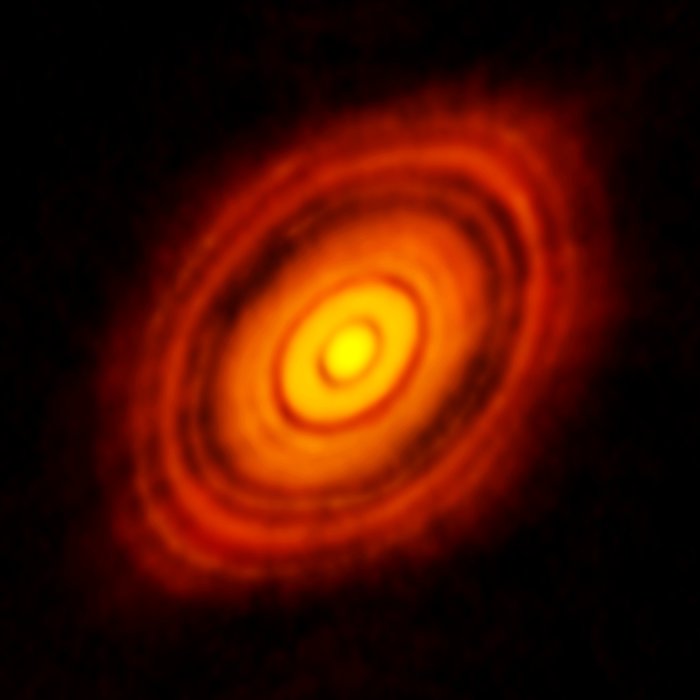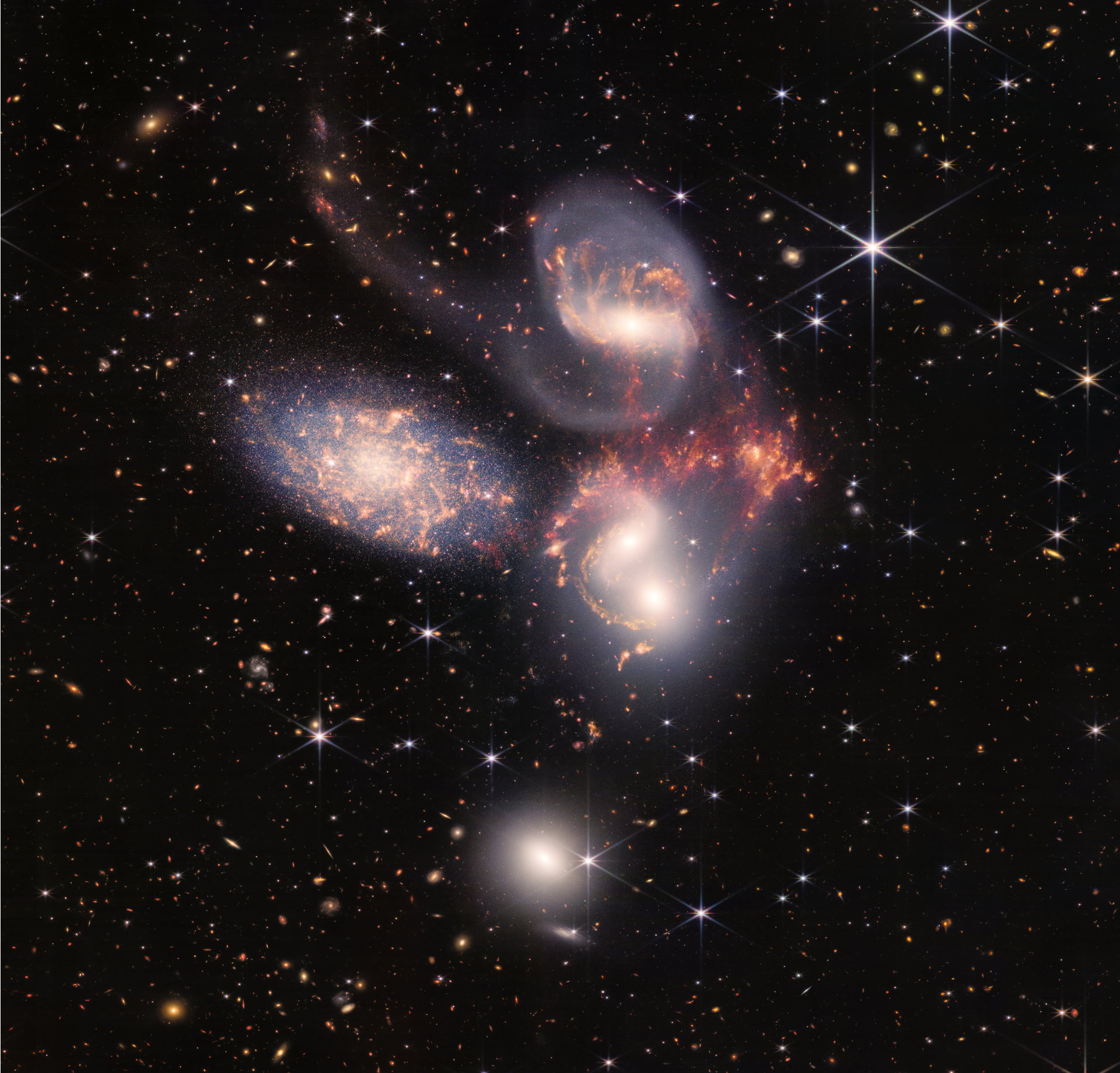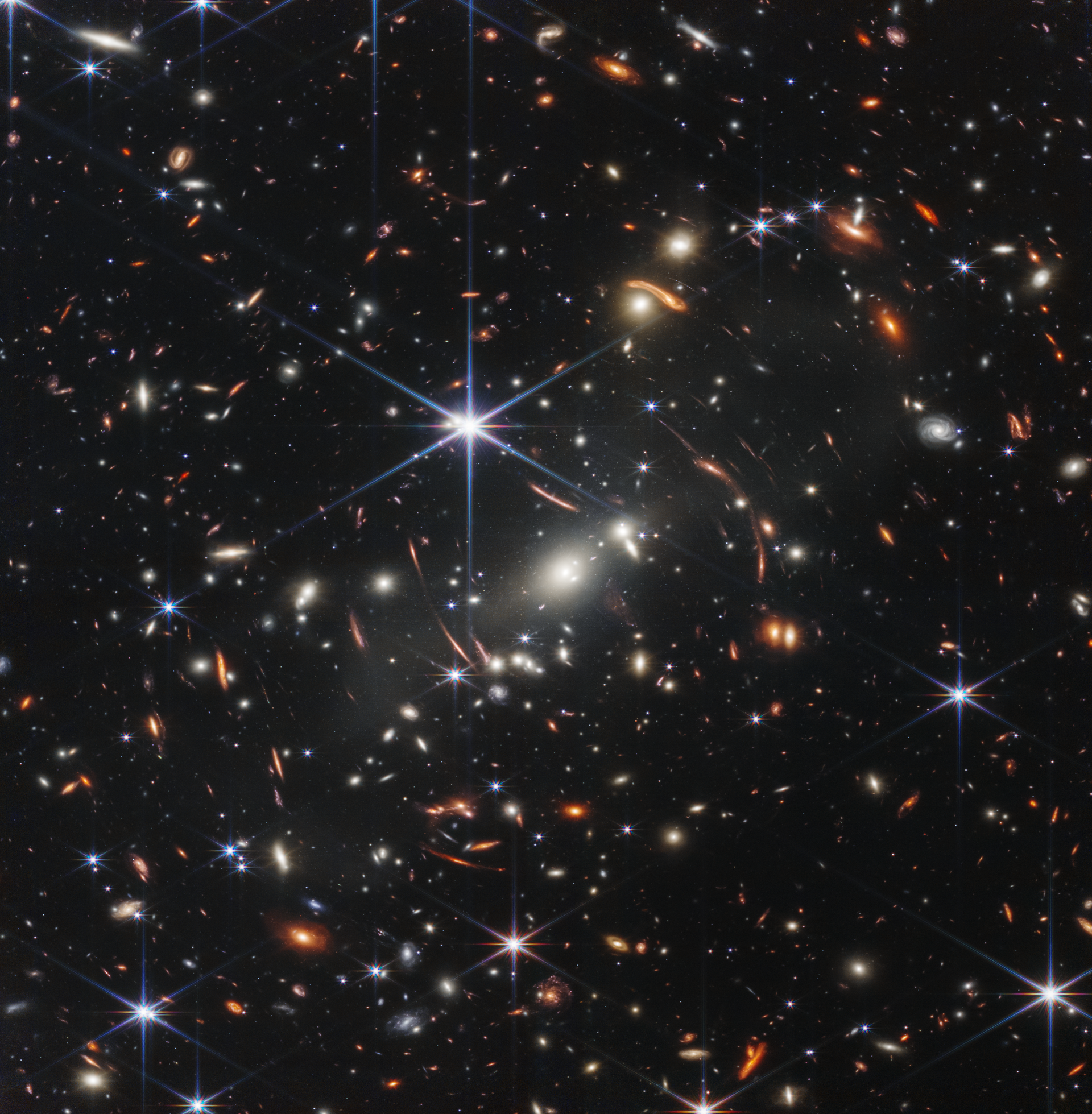From the Earth to the edge of the Universe
Over a sequence of 23 astronomical images representing the scale of the Universe, discover its incredible beauty.
This exhibition takes you on a journey from the surface of the Earth, with the VLT telescopes in Chile, to the edges of the Universe, with the first image of the James Webb Space Telescope's Deep Field, which contains galaxies about 13.2 billion light-years away.
A light-year is the unit used in astronomy to indicate the distance that light travels in a Julian year (365.25 days), at a speed of 299 792 458 meters per second. Thus, an object that is 1 light-year away from us is about 9 460 730 472 580 800 meters (about 9.46 trillion kilometers) away. This unit is used to measure distances to very distant astronomical objects, such as stars, galaxies, and quasars. For example, if a star is 10 light-years away, it means that the light we are now seeing from that star was emitted 10 years ago and is only now reaching us.
In addition to the astronomical content, all descriptions contain detailed information about the technique used to obtain the images.

|
2003 © NASA |
FROM THE EARTH TO THE EDGE OF THE UNIVERSE In this exhibition, you’ll be able to discover the beauty of the Universe, through a set of amazing astronomical images. It will take you on a trip, from the surface of the Earth, with the VLT telescopes in Chile, to the edge of the observable Universe, with the very first James Webb Space Telescope Deep Field, an image with galaxies at a distance of 13.2 billion light-years. A light-year is a unit, used in astronomy, that measures the distance light travels in a Julian year (365.25 days), at the speed of light (299 792 458 meter per second, or 670 616 629 miles per hour). This means that an object at a distance of 1 light-year is about 9 460 730 472 580 800 meters (9.46 trillion kilometers, or 5.88 trillion miles) away from us. This unit is used to measure the distance to very far astronomical objects, like stars, galaxies or quasars. For example, if a star is 10 light-years away, this means that the light from that star we are now seeing, actually left 10 years ago, and only now was able to reach us. |
|
September, 2016 © Y. Beletsky (LC ) / ESO |
Surface of the Earth Yepun Telescope Each of the main mirrors from the 4 units of the Very Large Telescope (VLT) is 8.2 meters (around 27 feet) in diameter and has huge supporting structures. To produce high quality observations, despite its dimensions, the structures have to move with high precision and smoothness. This image shows the VLT’s Unit 4 main mirror supporting structure. This unit was dubbed Yepun, which means “Venus - the evening star” in Mapuche language. The mirror weighs around 22 (metric) tons, but it’s only 18 cm (about 7.1 inches) thick. |
|
May, 2018 © ESO / G. Hüdepohl |
Surface of the Earth VLT Observatory, Chile The Very Large Telescope (VLT) is located in Cerro Paranal, in the Atacama Desert (Chile). It has a set of 4 main telescopes and 4 auxiliary telescopes, which are able to work independently but, when they work connected, like a network - using interferometric techniques - they have the equivalent light gathering power of a 16 meter telescope, and a resolution that corresponds to a 130 meter telescope. Both the main mirrors, each with 8.2 meters in diameter, and the secondary mirrors, each with 1.1 meters in diameter, are deformable, to be able to compensate for atmospheric turbulence. In order to work, this process needs to use bright stars as references and, when none are present in the telescope's field of view, powerful lasers are used to create artificial “stars” in the sky. |
|
February, 2015 © ESA/NASA |
1 millionth of a light-second away International Space Station Cupola Observational Module ISS is a science lab, where a wide range of scientific experiments are developed, which help to better understand life, both in space and on Earth. |
|
July, 2013 © NASA/GSFC/Arizona State University |
1.29 light-seconds away Moon It is thought that the Moon formed after a violent collision of a Mars-sized planet with the infant Earth. This impact sent to Earth’s orbit a huge amount of material from both planets, that gradually came together to form the Moon. By stabilizing the Earth’s axis, and as the cause of the tides, the presence of this natural satellite was pivotal for the development of life on Earth. This image, taken with Wide Angle Camera (WAC) aboard NASA’s Lunar Reconnaissance Orbiter (LRO) probe, has an impressive resolution of 100 meters (328 feet) per pixel. To get to this resolution, 110 000 individual images were used and a lot of processing hours were spent, which involved calculating the Sun’s incidence angle, the observation point and luminosity variations between each point in each image. |
|
September, 1999 © SOHO (ESA & NASA) |
8.4 light-minutes away Sun Violent phenomena frequently happen on the surface levels of the Sun, caused by its complex magnetic field. These phenomena often lead to ejections of solar material, which might hit the Earth and, in rare cases, cause disturbances in communication systems and electric systems in general. In this image we see the Sun with a huge prominence, about 30 times the size of the Earth. Prominences are made of dense and relatively cold ionized gas, which distances itself from the surface by following magnetic field lines; sometimes they are associated with coronal mass ejections (CME’s). This image was taken by the Extreme ultraviolet Imaging Telescope (EIT), aboard the Solar and Heliospheric Observatory (SOHO), a joint mission by NASA and ESA. |
|
July, 2013 © NASA / JPL-Caltech / SSI |
Between 67 and 95 light-minutes away Saturn In this image not only Saturn and its rings are visible, but also several of its moons and some Solar System planets (including Earth) as well. The planet itself is in backlight, because it’s eclipsing the Sun. Although we are observing the night side of Saturn, sunlight reflected in the rings illuminates a good portion of the planet’s dark disk, especially in higher latitudes. Besides the rings, usually visible from Earth with small telescopes or even large binoculars, we can also see in this image the more diffuse rings, like the most exterior E ring. This ring is created by the cryovolcanism phenomena in the moon Enceladus, which ejects water particles and other volatile materials to space. This is a composite of 141 images of three different filters (blue, red and green), taken by one of the cameras aboard NASA’s Cassini space mission. |
|
September, 2020 © ESO/Bohn et al. |
307 light-years away Multiple exoplanetary system The first exoplanet was discovered in 1995 by Michel Mayor and Didier Queloz. Since then, thousands of others have been discovered orbiting other stars. However, obtaining a direct image of a planet continues to be a challenge – until now, only a very small number have been observed directly. In this image, obtained with the SPHERE instrument installed on the ESO's Very Large Telescope, astronomers observed for the first time, directly, more than one planet orbiting a star similar to the Sun. The star TYC 8998-760-1, which is located 307 light-years away, is not visible to the naked eye. At only 17 million years old, it is a very young star, with mass and radius similar to that of the Sun. The planets TYC 8998-760-1b and TYC 8998-760-1c, marked in the image, are two gas giants with masses of approximately 14±3 and 6±1 times the mass of Jupiter, respectively, and they are very distant from the star, at approximately 162 and 320 astronomical units, respectively. To observe the planets, astronomers used a coronagraph, an instrument that blocks the light from the star, creating an artificial eclipse, allowing them to see the planets without being overwhelmed by the star's brightness. |
|
November, 2014 © ALMA (ESO/NAOJ/NRAO) |
450 light-years away Protoplanetary Disk of HL Tau Many young stars have gas and dust disks around them that, under the right conditions, can give rise to multiple planets, forming a planetary system. These disks can reach a radius about 1000 times greater than the distance from Earth to the Sun, with temperatures of up to around 700°C. In this image, we observe, in impressive detail, the protoplanetary disk around the star HL Tau, which is only about 1 million years old. In this disk, there are several bright rings interspersed with dark "gaps." These gaps may correspond to the orbits of forming planets, which clear the gas and dust in their vicinity. However, there are also other physical mechanisms that can produce similar gaps. This image was obtained through observations in the microwave band by the Atacama Large Millimeter/submillimeter Array (ALMA) with its largest configuration, involving antennas spread out over 15 kilometers. |
|
April, 1999 © ESO |
500 light-years away Barnard 68 Nebula Stars form when nebulas with sufficiently low temperature and density, known as molecular clouds, become unstable, sometimes due to external factors, and gravitational forces overcome the internal pressure of the cloud, causing it to collapse. In this image, we observe a molecular cloud in a precarious state of equilibrium that precedes collapse and star formation. The presence of this cloud scatters and absorbs the radiation emitted by background stars, rendering them invisible, and imparts a reddish hue to those stars that can still be seen through the cloud. This image is a composite of pictures taken with three different filters (blue, green-yellow, and infrared) using one of the telescopes at the Very Large Telescope (VLT). |
|
January, 2002 © ESO |
1300 light-years away Horsehead Nebula (Barnard 33) Some nebulas contain large amounts of dust, which absorbs and scatters the radiation from objects behind them. These types of nebulas are only visible when they are in front of a bright background, such as stars or a bright nebula. In this image, we observe a famous dark nebula that, due to a projection effect, appears to resemble the shape of a horse's head when viewed from Earth. This structure is only temporary because the nebula is being ionized by the intense ultraviolet radiation from nearby stars and will undergo noticeable changes on timescales of a few thousand years. This image is a combination of three different filters (blue, green-yellow, and red) taken with one of the telescopes at the Very Large Telescope (VLT). |
|
June, 2014 © Hubble image: NASA / ESA / C. Robert O’Dell (Vanderbilt Univ.) | Herschel data: ESA / Herschel / PACS & SPIRE / HerPlaNS survey / I. Aleman et al. |
2 thousand light-years away Spectrum of the Ring Nebula Spectroscopy is a technique used in astronomy that involves studying the intensity of electromagnetic radiation as a function of wavelength or frequency. Much of our knowledge about celestial objects is obtained through spectroscopy because by analyzing the spectrum of an object, we can infer its temperature, chemical composition, density, radial velocity, and many other physical properties. In this image, we observe the spectrum of the region of the Ring Nebula (Messier 57) contained within the white rectangle, in an infrared band. With this spectrum, we can learn about the chemical composition of this celestial object – emission lines have been identified that reveal the presence of carbon monoxide and the OH+ ion in this region of the nebula. The background image was obtained by the Hubble Space Telescope, while the data used to create this spectrum were obtained with the Herschel Space Observatory of the European Space Agency (ESA). |
|
November, 1999 © ESO |
6 thousand light-years away Crab Nebula High-mass stars end their lives in violent explosions known as Type II supernovae. These explosions eject large amounts of gas into interstellar space, forming a type of nebula called a supernova remnant. A supernova can also occur when the mass of a white dwarf, through accretion of matter, exceeds a critical value, causing the white dwarf to become unstable. These are known as Type Ia supernovae. In this image, we observe the remnant of a supernova whose explosion was recorded by Chinese astronomers in the year 1054. At the center of this supernova remnant lies a pulsar, which is a rapidly rotating neutron star. The pulsar in the Crab Nebula (Messier 1) completes 30 rotations per second while emitting radiation from its magnetic poles. By combining high rotation speeds and radiation emission in one direction, a neutron star resembles a beacon in space. This image is a composite of images obtained through one of the telescopes at the Very Large Telescope (VLT) using three different filters – blue, red, and ionized sulfur light, which indicate where there are shocks in the ionized gas. |
|
August - October, 2022 © NASA, ESA, CSA, STScI |
6,5 thousand light-years away Eagle Nebula and the Pillars of Creation Shortly after their formation, stars are still enveloped in a cocoon of gas and dust, remnants of the material that gave birth to them. Depending on their mass and the radiation they emit, this cocoon can dissipate faster or slower (in general, the higher the mass of the star, the faster it dissipates). In this image of the Eagle Nebula, you can see the so-called "Pillars of Creation", structures of gas and dust where intense star formation is occurring. These pillars are being eroded by the radiation from the already formed stars. Most of the stars visible in this image are either in the foreground or behind the nebula. The latter are visible through the nebula because this image was taken in the infrared region of the electromagnetic spectrum. This image is a composite of images from six different filters in the infrared region, obtained by the NIRCam instrument on the James Webb Space Telescope. |
|
June, 2011 © ESO / INAF-VST/ OmegaCAM. Acknowledgement: A. Grado / INAF-Capodimonte Observ. |
17 thousand light-years away Omega Centauri Globular Cluster Globular star clusters consist of a large number of stars densely packed together in a very compact and spherical arrangement, and they are generally the oldest objects in galaxies. The stellar formation within these clusters occurred simultaneously, allowing us to study how stars of different masses evolve. In this image, you can see the Omega Centauri globular cluster, which is the largest known globular cluster in our Galaxy, containing approximately 10 million stars. In its central region, this cluster is so dense that the stars are typically separated by distances similar to the size of the Solar System. However, Omega Centauri is not a typical globular cluster. It orbits the Milky Way in the opposite direction of the galaxy's rotation and follows a highly eccentric orbit, suggesting that Omega Centauri may have originally been the core of a dwarf galaxy that was captured by our galaxy. This image is a combination of images taken with three different filters (blue, red, and infrared) using the Survey Telescope of VLT (VST). |
|
May, 2022 © EHT Collaboration |
27 thousand light-years away Black Hole at the Heart of Our Galaxy For years, astronomers suspected that the object known as Sagittarius A* (Sgr A*) was a supermassive black hole located at the center of our galaxy. By studying the motion of stars around this object, which is located 27,000 light-years away, it was possible to estimate that it is a compact and extremely massive body, consistent with a black hole. The image shows the gas surrounding the black hole, which, due to the strong gravitational field, is rotating around it at speeds close to the speed of light. The diameter of this ring is approximately equal to the orbit of Mercury. The actual black hole is at the center of the ring and is not visible. To obtain this image, it was necessary to connect eight radio telescopes scattered around the world to create a powerful Earth-sized radio telescope array known as the Event Horizon Telescope (EHT). More than 300 researchers from 13 institutions around the world, and five years of work with supercomputers were required to analyze and combine the collected data. |
|
September, 2019 © ESO/VMC Survey |
160 thousand light-years away Large Magellanic Cloud (LMC) Located approximately 160 thousand light-years away, the Large Magellanic Cloud (LMC) is an irregular dwarf galaxy that is a satellite of the Milky Way. It is the fourth-largest galaxy in the Local Group of galaxies, following the Andromeda Galaxy (M31), the Milky Way itself, and the Triangulum Galaxy (M33). With a mass of 10 billion times that of the Sun, this galaxy is about 100 times less massive than the Milky Way. However, it is rich in gas and dust, and intense star formation is taking place within it. It contains the most active star-forming region in the entire Local Group, known as the Tarantula Nebula. Evidence of a spiral arm and a prominent bar at the center of this galaxy, with its sides closer to the Milky Way than the center, suggests that it was once a barred spiral galaxy whose structure was distorted by interactions with our own galaxy. The LMC covers an area of the sky approximately 20 times larger than the full moon and is one of the few deep-sky objects visible to the naked eye. It appears as a small diffuse cloud in the southern hemisphere sky. This image, captured by the VISTA telescope at the European Southern Observatory (ESO), is a combination of three filters in the infrared band. |
|
May, 2012 © NASA/JPL-Caltech |
2,5 million light-years away Andromeda Galaxy The Andromeda Galaxy is the nearest large galaxy to the Milky Way. Like our own galaxy, it is a spiral galaxy with a core of older stars surrounded by a set of spiral arms composed of younger stars and dust clouds. The visible structure of the Andromeda Galaxy spans about 260,000 light-years, and because it is only 2.5 million light-years away, it occupies an area in the sky four times larger than the full moon. It is estimated that the Andromeda Galaxy contains around 200 billion stars. This image was created from 11 different images captured by NASA's Galaxy Evolution Explorer (GALEX) space telescope, which observes the universe in the ultraviolet band. The yellow channel corresponds to near-ultraviolet (less energetic) light, while the blue channel represents far-ultraviolet (more energetic) light. |
|
January, 2009 © ESO / WFI (Optical); MPIfR / ESO / APEX / A. Weiss et al. (Submillimetre); NASA / CXC / CfA / R. Kraft et al. (X-ray) |
13 million light-years away Centaurus A Radio Galaxy Radio galaxies are galaxies with highly active nuclei, emitting strong radiation in the radio band and featuring jets of material expelled from the central region. The intense activity in the nuclei of radio galaxies is believed to result from the presence of a supermassive black hole. In this image, we observe the Centaurus A galaxy, which appears to have significant amounts of dust in the visible spectrum. The combination of images obtained in the X-ray and radio bands allows us to also see a jet of particles emitted from a region at the center of the galaxy with a diameter of only 0.03 light-years. This region is thought to contain a supermassive black hole with approximately 100 million times the mass of the Sun. This image is a composite of five images obtained with the MPG/ESO telescope (visible), the Atacama Pathfinder Experiment (radio), and the Chandra X-ray Observatory. |
|
September, 2010 © ESO / P. Grosbøl |
60 million light-years away NGC 1365 Galaxy Spiral galaxies can have a central bar from which spiral arms emerge. The bars are typically composed of predominantly older stars, which appear yellow or reddish in color, while the spiral arms are generally made up of younger stars, which appear bluish. In this image, we observe the spiral galaxy NGC 1365, which contains a prominent central bar and only two spiral arms. This galaxy, part of the Fornax Cluster, has a diameter of approximately 200,000 light-years, making it a giant galaxy. The image is a composite of images obtained with four different filters in the infrared region using one of the telescopes at the Very Large Telescope (VLT). |
|
March, 1999 © ESO |
170 million light-years away ESO 510-13 Galaxy Spiral galaxies contain significant amounts of gas and dust, which are predominantly distributed in a plane, forming a disk. In this image, we observe a spiral galaxy edge-on, meaning we are viewing it from a direction almost parallel to the plane of the disk. This galaxy has the particularity of presenting a distorted disk. The distortion likely occurred recently, likely due to an interaction with another galaxy, and it hasn't had enough time to settle into a more stable shape. This image is a composite of images taken with three different filters (green-yellow, red, and infrared) using one of the telescopes at the Very Large Telescope (VLT). |
|
July, 2022 © NASA, ESA, CSA, STScI |
290 million light-years away Stephan's Quintet Galaxies are large conglomerates primarily composed of star systems, gas, and dust and can exhibit various forms. One of the mechanisms influencing the morphology of galaxies is their interaction with other galaxies. This phenomenon can trigger bursts of star formation, cause a transfer of material between galaxies, or even lead to the merger of the involved galaxies, resulting in giant elliptical galaxies. Despite its name, Stephan's Quintet consists of four galaxies that form a compact group interacting with each other. The fifth galaxy, NGC 7320, seen more to the left, does not belong to the group – it is much closer, at about 40 million light-years away. This 150-million-pixel image is a composite of over 1000 images in the infrared band obtained by the NIRCam (blue and white colors) and MIRI (yellow and orange colors) instruments aboard the James Webb Space Telescope (JWST). |
|
January, 2014 © NASA, ESA, J. Lotz, M. Mountain, A. Koekemoer e a equipa HFF (STScI) |
Around 4200 million light-years away Abell 2744 Galaxy Cluster Galaxy clusters typically consist of several hundred galaxies, and due to their high mass, they can exhibit the gravitational lensing effect. This effect alters the path of light emitted by a distant object and, similar to looking through the bottom of a bottle, can result in the formation of multiple images of that object or distorted images such as arcs or rings. This phenomenon allows for the estimation of the cluster's mass and also serves as a test of the physics that describes gravity. Today, we know that a significant part of a galaxy cluster's mass is made up of a special type of matter that does not emit or absorb light, known as dark matter. In this image, we can observe several distant galaxies that have been distorted by the gravitational lensing effect, giving them an elongated appearance. This image is a composite of images obtained with seven different filters in the visible and infrared regions using the Hubble Space Telescope. |
|
July, 2022 © NASA, ESA, CSA, STScI |
Up to 13,2 billion light-years away First Webb Deep Field One of the primary scientific goals of the James Webb Space Telescope (JWST) is to observe the first galaxies formed in the Universe. This Deep Field image was one of the first obtained by the JWST when it became operational and, as expected, it revealed previously unknown galaxies. By analyzing the spectrum of one of these new galaxies, astronomers were able to determine that its light took 13.2 billion years to reach us. Due to the expansion of the Universe over time, the wavelength of the originally emitted visible light has been stretched, and we now observe it in the infrared band. This is one of the reasons why the JWST observes the Universe in these wavelengths. In this image, thousands of galaxies can be seen. In the center is a massive elliptical galaxy, closer to us, which is responsible for the visible distortions in the image. This deep field image, which corresponds to a patch of sky the size of a 1 Euro coin observed from a distance of 40 meters, is a composite of multiple exposures totaling 12.5 hours of observation. The images in the near-infrared band were obtained with the NIRCam instrument on board the JWST. |
|
From the Earth to the edge of the Universe Conception and contents: Daniel Folha, Pedro Mondim e Paulo Pereira Scientific content and review: Jarle Brinchmann, Daniel Folha, Pedro Mondim, Filipe Pires e Ricardo Reis Translation: Daniel Folha, Elsa Moreira e Ricardo Reis Design and communication project: Paulo Pereira Planetário do Porto – CCV, Porto, 2014, 2023 |
|

 Rua das Estrelas, 4150-762 Porto
Rua das Estrelas, 4150-762 Porto
T. +351 226 089 800 (chamada para a rede fixa nacional)
geral@planetario.up.pt
Mapa e como chegar

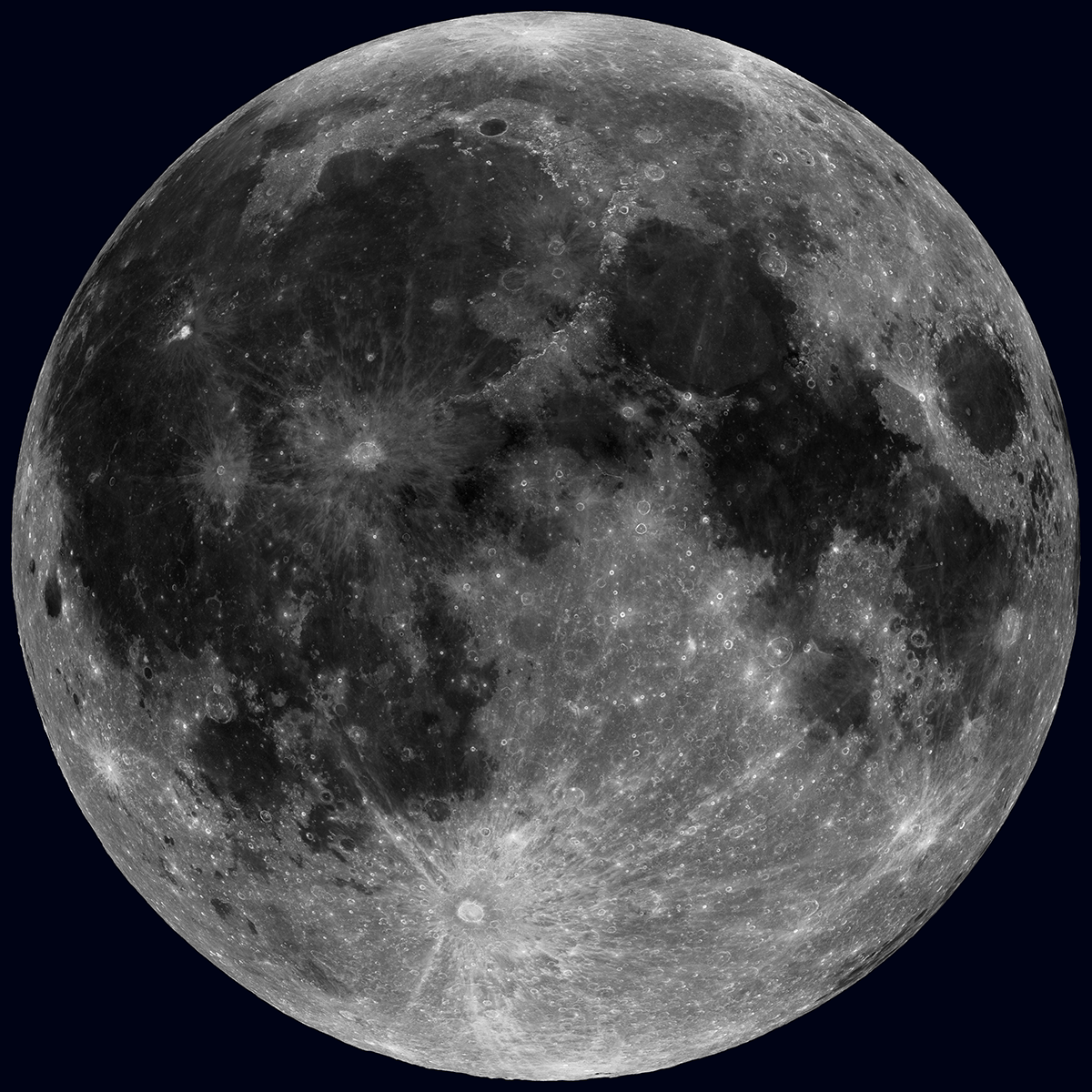
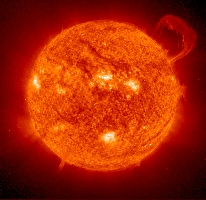 Solar prominence.
Solar prominence.